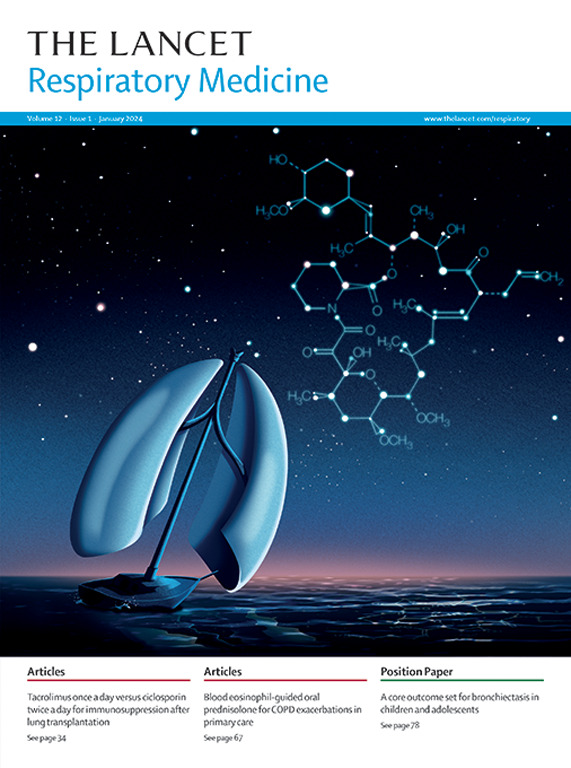Symptoms, risk of future exacerbations, and response to long-term macrolide treatment in bronchiectasis: an observational study
IF 32.8
1区 医学
Q1 CRITICAL CARE MEDICINE
引用次数: 0
Abstract
Background
Previous studies have suggested that daily symptoms are a marker of bronchiectasis disease activity and could therefore identify patients at increased risk of exacerbation. However, international bronchiectasis guidelines recommend long-term macrolide treatment only in patients with three or more exacerbations per year. We aimed to investigate if symptoms independently predict future exacerbations and therefore identify additional responders to long-term macrolide treatment.Methods
We used data from the EMBARC registry, a multicentre international bronchiectasis database. Baseline symptoms were evaluated with the quality-of-life bronchiectasis questionnaire respiratory symptoms score (QoL-B-RSS), followed-up for at least 1 year, and were related to the future risk of exacerbations. We subsequently conducted a post-hoc pooled analysis of three randomised controlled trials of macrolides (ie, BLESS, BAT, and EMBRACE) in 341 participants with bronchiectasis to determine if baseline symptoms were associated with response to long-term macrolide treatment, using a negative binomial regression model.Findings
9466 patients from the 19 324 patients included in the EMBARC registry had available QoL-B-RSS assessment at baseline and 1-year follow-up. The median age was 68 years (IQR 58–74), 5763 (60·9%) were female, and 3703 (39·1%) were male. The median Bronchiectasis Severity Index score was 7 (4–10) and Pseudomonas aeruginosa was present in the sputum of 2041 (21·6%) patients within 12-months of baseline. Previous exacerbations (rate ratio (RR) for every additional exacerbation 1·11, 95% CI 1·10–1·12; p<0·0001) and symptoms (RR for every 10 points lower QoL-B-RSS 1·10, 1·09–1·11; p<0·0001) were identified as independent risk factors for future exacerbations. The number of exacerbations during 1-year of follow-up was similar between patients with three or more exacerbations at baseline and average symptom scores (QoL-B-RSS 60–70; RR 1·58, 95% CI 1·48–1·69) and the group with no previous exacerbations but high symptom scores (RR 1·55, 1·41–1·70). The same pattern was observed in the post-hoc analysis of randomised controlled trials, both in the macrolide and placebo groups. The number-needed-to-treat to prevent exacerbations with long-term macrolide therapy was similar for patients selected based on frequent exacerbations (1·45, 95% CI 1·08–2·24) and in those with few previous exacerbations, but high symptom scores 1·43 (1·06–2·18).Interpretation
Our results suggest that symptoms are an independent risk factor for future exacerbations in bronchiectasis. Patients who are highly symptomatic derive a similar benefit from macrolide treatment as patients with a high baseline exacerbation frequency.Funding
EU, European Federation of Pharmaceutical Industries and the Associations Innovative Medicines Initiative Inhaled Antibiotics in Bronchiectasis and Cystic Fibrosis Consortium, European Respiratory Society.支气管扩张的症状、未来恶化的风险和对长期大环内酯治疗的反应:一项观察性研究
背景:先前的研究表明,日常症状是支气管扩张疾病活动性的标志,因此可以识别病情恶化风险增加的患者。然而,国际支气管扩张指南建议长期大环内酯类药物治疗仅适用于每年发作3次或3次以上的患者。我们的目的是研究症状是否能独立预测未来的恶化,从而确定长期大环内酯治疗的其他应答者。方法:我们使用来自EMBARC注册中心的数据,这是一个多中心的国际支气管扩张数据库。基线症状通过生活质量支气管扩张问卷呼吸症状评分(QoL-B-RSS)进行评估,随访至少1年,并与未来恶化风险相关。随后,我们使用负二项回归模型,对341名支气管扩张患者进行了大环内酯类药物(即BLESS、BAT和EMBRACE)的三项随机对照试验进行了事后汇总分析,以确定基线症状是否与长期大环内酯类药物治疗的反应相关。结果:在EMBARC登记的19324例患者中,9466例患者在基线和1年随访时进行了QoL-B-RSS评估。中位年龄为68岁(IQR 58 ~ 74),女性5763例(60.9%),男性3703例(39.1%)。支气管扩张严重程度指数中位数评分为7(4-10),2041例(21.6%)患者在基线后12个月内痰中存在铜绿假单胞菌。既往加重(每加重一次的发生率比(RR) 1.11, 95% CI 1.10 - 1.12;p< 0.0001)和症状(QoL-B-RSS每降低10个点的RR为1.10,1.09 - 1.11;p< 0.0001)被确定为未来病情恶化的独立危险因素。基线和平均症状评分有3次或3次以上加重的患者(QoL-B-RSS 60-70; RR 1.58, 95% CI 1.48 - 1.69)和既往无加重但症状评分高的组(RR 1.55, 1.41 - 1.70)随访1年期间加重次数相似。在随机对照试验的事后分析中,在大环内酯组和安慰剂组中也观察到相同的模式。根据频繁发作的患者(1.45,95% CI 1.08 - 2.24)和以前很少发作但症状评分较高的患者(1.43,1.06 - 2.18)选择长期大环内酯治疗预防加重所需治疗的数量相似。我们的研究结果表明,症状是支气管扩张未来恶化的独立危险因素。重度症状患者从大环内酯治疗中获得的益处与基线加重频率高的患者相似。资助eu,欧洲制药工业联合会和协会创新药物倡议支气管扩张和囊性纤维化吸入抗生素联盟,欧洲呼吸学会。
本文章由计算机程序翻译,如有差异,请以英文原文为准。
求助全文
约1分钟内获得全文
求助全文
来源期刊

Lancet Respiratory Medicine
RESPIRATORY SYSTEM-RESPIRATORY SYSTEM
CiteScore
87.10
自引率
0.70%
发文量
572
期刊介绍:
The Lancet Respiratory Medicine is a renowned journal specializing in respiratory medicine and critical care. Our publication features original research that aims to advocate for change or shed light on clinical practices in the field. Additionally, we provide informative reviews on various topics related to respiratory medicine and critical care, ensuring a comprehensive coverage of the subject.
The journal covers a wide range of topics including but not limited to asthma, acute respiratory distress syndrome (ARDS), chronic obstructive pulmonary disease (COPD), tobacco control, intensive care medicine, lung cancer, cystic fibrosis, pneumonia, sarcoidosis, sepsis, mesothelioma, sleep medicine, thoracic and reconstructive surgery, tuberculosis, palliative medicine, influenza, pulmonary hypertension, pulmonary vascular disease, and respiratory infections. By encompassing such a broad spectrum of subjects, we strive to address the diverse needs and interests of our readership.
 求助内容:
求助内容: 应助结果提醒方式:
应助结果提醒方式:


